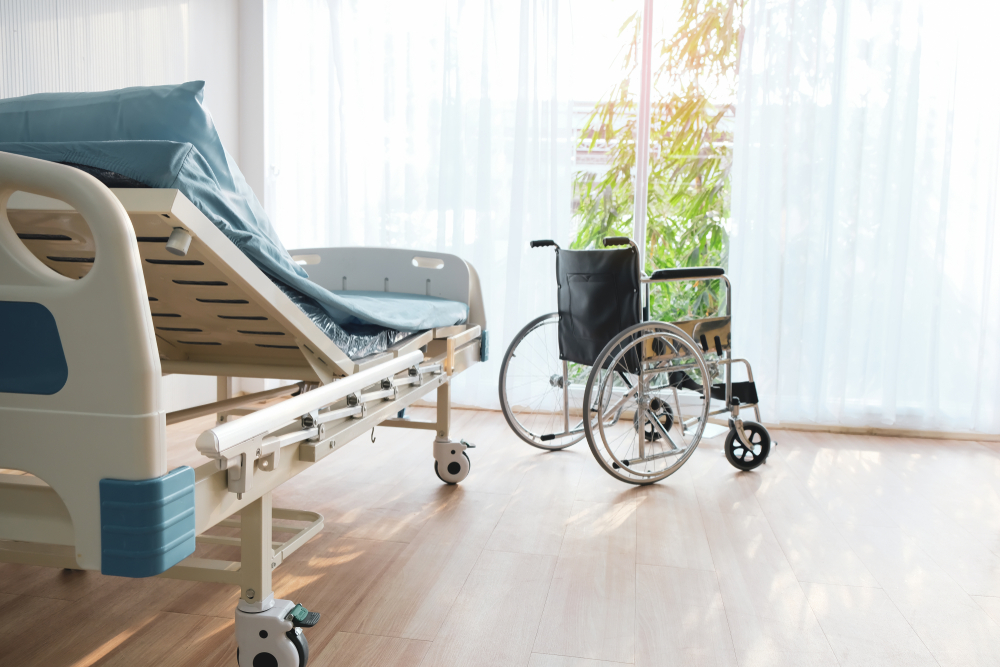Purchasing a home hospital bed can be intimidating and emotional. Whether you’re looking for a temporary solution for a loved one or a long-term purchase for yourself as an older adult, there are options to fit your needs. Here’s what you need to consider when shopping for home hospital beds to ensure comfort, safety, and durability.
Things to Consider
Before you make your decision about home hospital beds, evaluate your situation. Ask yourself the following questions:
- How many hours per day will the bed be used?
- How long will the bed be needed? Could a short- or long-term rental suffice?
- Can the user transfer independently or will they need a sling to transfer in and out?
- Does the user have other medical needs in addition to their mobility issues?
Types of Hospital Beds
There are two main types of home hospital beds you’ll want to consider: semi-electric and fully-electric.
Semi-Electric
Semi-electric home hospital beds are a practical and affordable option. While the head and foot positions are typically adjusted automatically, the height is adjusted manually with a hand crank. A semi-electric home hospital bed will require assistance from an able-bodied family member or caregiver living in the home.
If you’re unsure if the caregiver in question will be able to operate the crank themselves, we invite you to stop by any of our locations to try it out firsthand! Our expert technicians are always here to help.
Fully-Electric
Fully-electric home hospital beds provide optimal comfort and are easily adjusted independently – without even leaving the bed! The height, head, and foot positions can all be adjusted by the user or a caregiver with a simple remote. A fully-electric bed can offer significant independence and comfort to its user.
Features
Once you’ve determined if a fully-electric or semi-electric home hospital bed is right for you, you’ll want to consider a few other features to help make your final decision.
Transfer Styles
If the user of the home hospital bed is not ambulatory, you’ll need to consider how to perform transfers in and out of their wheelchair or mobility scooter. A powered lift is a great option for bariatric users, but manual slings can also be a good option for many individuals.
There are also beds that allow the user to shift into a sideways seated position to prepare for transfer. Check out the ActiveCare Auto-Pivot Bed in our product recommendations below for more info!
Low Beds
If the user is at risk of falling, low home hospital beds are a great option. Designed with safety in mind, these beds are closer to the ground to reduce the risk of injury if the user falls out of bed while sleeping or loses balance while transferring. You can also add bed rails to reduce the risk of injury, even from a low bed.
Head, Foot, and Knee Positions
Many home hospital beds include adjustable features to raise the head, feet, and knees. If the user likes to sit up while reading or watching television, or needs to keep their legs elevated for better blood circulation, look into a bed that simultaneously raises the head and knees for optimum comfort.
Accessories
There are numerous accessories available for home hospital beds. Customize your bed with tray tables, railings, side rail pads, gap sleeves, assist bars and handles, bedside caddies, and much more for safety, comfort, and ease-of-use.
Specialty Beds
If you’re looking for home hospital beds that are more specific to your use case, pediatric and bariatric home hospital beds are also available.
Pediatric beds come in many styles, but are often adjustable to grow with your child. While a standard home hospital bed has a weight capacity of approximately 400 lbs., some bariatric beds can hold individuals weighing up to 1,000 pounds.
The Top Five Best Hospital Beds
Now that you’ve learned a bit more about home hospital bed features and options, let’s take a look at the top five hospital beds for home use that we recommend.
As discussed above, the rotating feature in this bed makes it the best choice for individuals who struggle with transferring out of bed. With a weight capacity of up to 600 lbs., the automated SafeTurn system makes it easy to sit up from a reclined position, turn to the side, and exit the bed freely.
In our opinion, this is the most versatile, cost-effective, fully-electric home hospital bed on the market. With a sleek design, the bed is fully-equipped with safety features for both the user and caregiver. These features include independent head and knee adjustments plus electronic height adjustment ranging from 7.8 to 26.5 inches.
The Aura™ Premium Home Hospital Bed is the best choice for individuals who need the function and safety of a home hospital bed, but still desire the style and look of a standard bed. These versatile beds are best suited for permanent use.
Looking for a short-term hospital bed rental? The Tuffcare Century T3000 is perfect for temporary use due to its two-piece grid design, making it easy to install and dismantle. This fully-electric bed is equipped with a remote allowing the user to raise or lower the bed’s height, the head frame, and the foot frame.
The Invacare CS7 home hospital bed is considered the industry standard for long-term care. They include an Auto Contour feature to simultaneously raise the head and knees and are perfect for those who like to read or watch TV from their bed.





